Cosmic Frontier
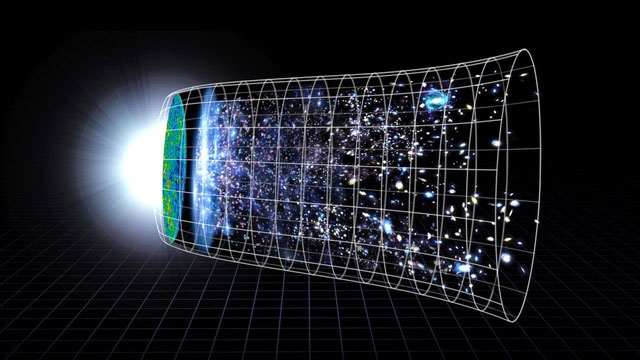
(See NASA, 9/20/2016)
Table of Contents
- Major Dark Matter projects
- Major Dark Energy projects
- Major Cosmic Microwave Background projects
The Office of High Energy Physics mission is to understand how our universe works at its most fundamental level. As such, HEP's traditional support for accelerator based research in particle physics is augmented by research in the Cosmic Frontier, defined loosely as the study of fundamental particles and forces using naturally occurring phenomena. The 2014 P5 study and report identified five important science drivers:
- Use the Higgs boson as a new tool for discovery
- Pursue the physics associated with neutrino mass
- Identify the new physics of dark matter
- Understand cosmic acceleration: dark energy and inflation
- Explore the unknown: new particles, interactions, and physical principles.
These science drivers are not prioritized above, because they are intertwined in fundamental ways, some known and some yet to be known. The last four in the above list involve projects directly managed as part of the HEP Cosmic Frontier.
Cosmic Frontier projects investigate the mass-energy content of the universe (with fractions shown above), and associated dynamics from the moment of the Big Bang to the large scale structure observed today, some 13.7 billion years later. The goal is to understand the nature of the Dark Matter and Dark Energy that make up 95% of the known mass-energy of the universe by using particles from space to explore new phenomena. Such exploration has, so far, revealed a universe far stranger than ever thought possible.

Mass-energy content of the universe:
68.5% Dark Energy, 26.5% Dark Matter, 4.9% Baryonic (stars & planets, gas, dust)
Particle Data Group, LBNL, 2020
The Standard Model of cosmology (called ΛCDM) weaves a coherent picture of how Dark Matter and Dark Energy fit together and allow us to understand the universe in detail, starting at the beginning of the Big Bang through nucleosynthesis and star formation up to and including the large scale structure we see today. By studying the Cosmic Microwave Background (CMB), we can learn about the universe in the first instant of the Big Bang during what is known as the Inflationary era. The Cosmic Frontier program also includes a CMB project that will directly investigate the Inflation period via ultra high precision measurement of the CMB polarization.
Cosmic Frontier researchers use diverse tools and technologies, from space-based observatories to ground‐based telescopes and large detectors deep underground, to probe fundamental physics questions and offer new insight about the nature of Dark Matter, Dark Energy, Inflation, and other phenomena. All of these projects in Dark Matter, Dark Energy, and CMB have the full backing of HEPAP and P5, and constitute collaborations consisting of scientists at Universities and the various DOE national labs.
Dark Matter (DM): LZ, ADMX, SuperCDMS
Observations of the universe have revealed that only around 5% of its mass-energy is from the well-known baryonic matter that constitutes stars, planets, and interstellar hydrogen, helium, and dust. The remaining ~27%, called "Dark Matter", is made up of some kind of unknown material that has mass, and is not observable via the electromagnetic force. Being far more abundant than regular baryonic matter (Dark Matter makes up 80-85% of the mass of a typical galaxy like the Milky Way), Dark Matter dominates the gravitational dynamics of mass in the Universe, and without it, galaxies (including the Milky Way) and clusters of galaxies would not exist in the way they do today, and the large-scale structure of the universe would be quite different than what is observed today.
There are many potential theories of Dark Matter, from particles to black holes, having masses from tiny fractions of the electron mass all the way up to thousands of times the mass of the sun. There are also theories that suggest that the known effects of Dark Matter (for instance galaxy rotation curves, large scale structure, and the Bullet Cluster) could be explained by modifying general relativity, the 4-dimensional theory that connects gravity to space-time geometry. Today's leading theory of Dark Matter is that it is made up of particles that interact very rarely with normal baryonic matter. These dark matter particles are postulated to be left over from the Big Bang and might be observable with experiments at the other 2 HEP Frontiers: Energy and Intensity. However, only experiments at the Cosmic Frontier can directly detect determine that such particles actually constitute the dark matter observed in the universe. The bottom line is that we don't know what theory of Dark Matter is correct, a giant hole in our understanding of the fundamentals of the universe itself. There is overwhelming evidence for the existence of Dark Matter, but its nature (particles, masses, interaction cross-sections, couplings, etc) remains a mystery.
LZ
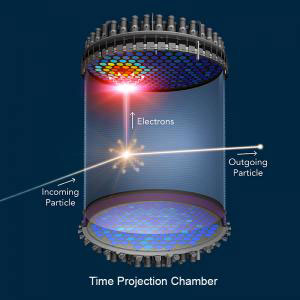
Simulated depiction of an event in the LZ time projection chamber (TPC). (Credit: SLAC)
The LZ experiment merges previous efforts by the LUX (Large Undergroud Xenon) and ZEPLIN (ZonEd Proportional scintillation in LIquid Nobel gases) experiments into a next generation ("gen 2") dark matter experiment. The project is led by LBNL and hosted in the Davis Campus at the Sanford Underground Research Facility (SURF) in Lead, South Dakota. As of February 2021, the LZ collaboration consists of 250 scientists and engineers from 37 institutions in the US, UK, Portugal, and Korea, including participation of scientists from LBNL, BNL, Fermilab, LLNL, and SLAC. The goal of LZ will be in the direct detection of the faint interactions between galactic dark matter particles and regular matter particles in the lab by operating an ultra low noise experiment, deep underground so as to minimize the effects from cosmic rays.
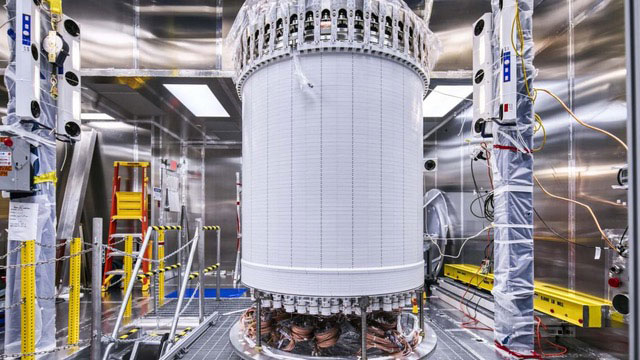
The recently assembled LZ detector in the Surface Assembly Lab clean-room at SURF on July 26, 2019. (Credit: Matthew Kapust, SURF.)
The core of the LZ detector is a large liquid xenon time projection chamber that collects two scintillation signals from particle interactions in the liquid: S1, from the de-excitation of short-lived xenon molecules, and S2, from electrons liberated at the event site that are extracted into the gas phase where they undergo electro-luminescence. The S2 hit pattern gives the lateral position and the S2-S1 time difference gives the depth of the event. This localization allows for selection of (WIMP) candidates in the center of the detector where external radioactive backgrounds do not readily penetrate.
As of early 2021, LZ is being commissioned underground in the Davis Campus with first data expected to follow later in the year.
Super Cryogenic Dark Matter Search (SuperCDMS)
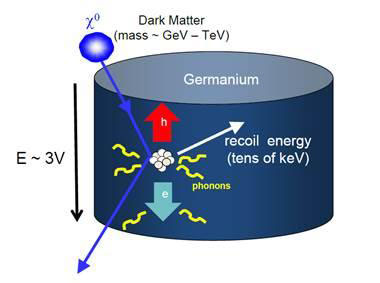
Schematic of the interaction of a dark matter particle with a nucleus
inside the SuperCDMS detector. Credit:
SLAC
The prevailing models for dark matter particles predict that they interact only very weakly with baryonic matter. Laboratory detection therefore has to consist of experiments that are extremely sensitive to the small energy depositions that would come from a dark matter particle scattering from either a nucleus or atomic electrons. SuperCDMS uses very pure silicon and germanium detectors equipped with superconducting transition edge sensors (TESs) to detect such small energy depositions. TESs use materials that have a well defined and rather sharp "transition" (or "critical") temperature (Tc), defined as the temperature where they go from normal conduction to superconducting. By setting the temperature of these materials right at the Tc, if any Dark Matter particle were to interact with a nucleus in the material, it would release a small amount of energy, which would drive the temperature of the material up enough to transition from superconducting to normal, a transition that is much easier to measure. SuperCDMS detectors thus have to be cooled by special (dilution) refrigerators to ultra-cold temperatures (< 30 thousandths of a degree above absolute zero). Similar transition edge sensors are also used by CMB-S4 (see below), and many other experiments.
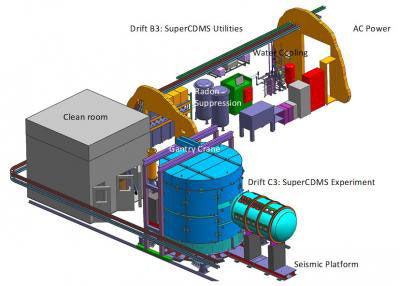
SuperCDMS model at SNOLAB. Credit: SLAC.
SuperCDMS detectors also have to be shielded from the environment, using a combination of copper, lead, plastic and water shielding materials. The experiment needs to be located deep underground to avoid high energy particles from space (cosmic rays). SuperCDMS previously operated in the Soudan Underground Laboratory in northern Minnesota but the new experiment is being built 6800 meters underground at SNOLAB near Sudbury, Ontario, Canada.
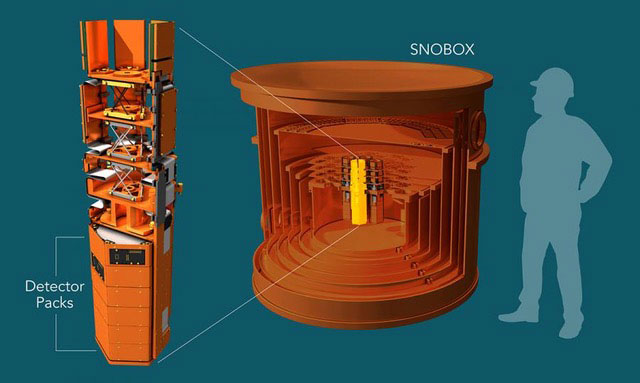
Diagram of the SuperCDMS cryostat and detector setup. Credit: SLAC.
The project is a collaboration between various universities in the US, Canada, France, India, and Spain, and scientists at the DOE national labs Fermilab, and PNNL, and SLAC, with support from the National Science Foundation (NSF) and the Canada Foundation for Innovation.
As of early 2021, SuperCDMS is under construction.
ADMX

The ADMX insert being extracted from the magnet bore for upgrades. The mist pouring off the edges is air condensing on the cryogenic surface as the insert warms. Photo Credit: Rakshya Khatiwada, UW
The Axion Dark Matter eXperiment, ADMX, is an experiment to detect dark matter particles using a resonant microwave cavity inside a large superconducting magnet. ADMX is a 2nd generation (gen-2) dark matter experiment supported DOE HEP (with past support by NSF), and is located at the University of Washington, Seattle. ADMX is a collaboration of scientists from various universities, the National Radio Astronomy Observatory, and from the DOE labs LLNL, LANL, Fermilab, and PNNL.
ADMX is an example of how particle physicists make use of advanced technology in order to measure new phenomena. Here, physicists look for the axion, a particle with unique coupling properties and an extremely small and unknown mass that is postulated to address problems in quantum field theory that has to do with the strong nuclear force. The axion could conceivably also be the answer to the question of what makes up the Dark Matter. If the axions exist, and are the Dark Matter particle, then they would make up 80% of the mass of the galaxy and we should be swimming in a sea of axions.

From Rosenberg, PNAS, 2015, Dark-matter QCD-axion searches, 112, (40), 12278-12281.
The mass and coupling strength of axions is small, or it would have been detected already and theories of axions postulate that they would interact very weakly with photons. The ADMX approach is to detect axions via their interaction with photons inside a very high-Q (between 105 and 106) tunable microwave cavity, as shown above. An axion-photon interaction would deposit energy inside the cavity, so they "tune" the cavity's resonance frequency by adjusting metal or dielectric rods to change the cavity resonance condition, which means that data taking is accomplished by scanning over a set of frequencies. Since the interaction is so small, readout noise has to be minimized, and this is accomplished using technology now common in Quantum Information Science (QIS): ADMX amplifies the signal using a superconducting quantum interference device (SQUID) packaged into a Josephson parametric amplifier operating in the 200 mK range.
Since photon density and EM field density are quantum/classical analogs, ADMX maximizes the probability of a photon-axion interaction by placing the cryostat and cavity inside an intense magnetic field generated by an 8 Tesla superconducting magnet.
As of early 2021, ADMX is taking data.
Dark Energy (DE): DESI and Vera Rubin Observatory
The surprising discovery in 1998 that the expansion of the universe is accelerating, instead of slowing down due to gravity, poses a significant question: what is the "dark energy" that is pushing our universe apart? While it may be an inherent feature of the universe, it could be something dynamic related to new particles or forces, or a failure of Einstein's theory of General Relativity on extremely large distance scales. While we do not yet know the nature of this Dark Energy and how it is related to the Big Bang and shapes the universe as it expands, we do know that it constitutes around 70% of the mass-energy in the universe, and that understanding Dark Energy will tell us something about not only the deep fundamental nature of the universe, the Big Bang, and origins of large scale structure, it will also tell us something about the ultimate fate of the universe.
Dark Energy Spectroscopic Instrument (DESI)
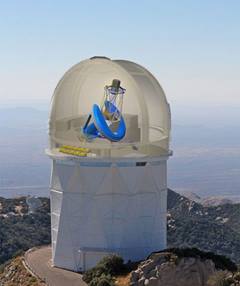
DESI at NSF's Kitt Peak Observatory Mayall telescope. Credit: R. Lafever, J. Moustakas/DESI Collaboration, P. Marenfeld/NOAO/AURA/NSF & E. Acosta/Vera C. Rubin Observatory/ NOIRLab/ NSF/ AURA
The Dark Energy Spectroscopic Instrument, DESI, is a stage-IV dark energy project that brings together more than 750 researches from over 90 institutions from the U.S., Australia, Canada, China, Colombia, France, Germany, Korea, Mexico, Spain, Switzerland, and the U.K., with participation from the DOE national labs LBNL, BNL, Fermilab, and SLAC, and with contributions from the NSF, Heising-Simons Foundation, Gordan and Betty Moore Foundation, the Sciences and Technology Facilities Council (UK), CEA (France), CONACYT (Mexico), and Gobierno de Espana (Spain).
The DESI project is managed by LBNL, with the survey instrument situated at the NSF Kitt Peak National Observatory in Arizona on the 4-meter NSF Mayall telescope. DOE leases the telescope from NSF. By creating largest 3-dimensional map of the universe, DESI will measure the expansion of the universe and the effect of Dark Energy. DESI will gather distant light as old as 11 billion years onto fiber optics for optical spectroscopic analysis, determining the red shift and thus the relative velocity of galaxies. In tern, the relative velocity is used to calculate the distances to the galaxies, providing researchers with the third dimension of the sky map. To successfully conduct its experiment, the DESI instrument will provide unprecedented multi-object spectroscopy incorporating a novel design consisting of corrector optics that provides a 3-degree diameter field of view that feeds a focal plane containing 5,000 computer controlled robotic fiber optic positioners. The positioners can be reconfigured in 2 minutes to precisely align each fiber head with a target galaxy. The light collected passes through fibers that extend 50 meters down the telescope to feed multiple broad-band spectrographs each containing ultra-low-noise photon detectors spanning the blue to near-infrared wavelengths.
 See https://arxiv.org/pdf/1807.09287v1.pdf |
 View of the DESI focal plane with 5,000 fiber positioner robots. Each robot is computer-controlled to position the optical fiber precisely on target. Altogether the focal plane contains 300,000 moving parts. Credit: DESI Collaboration |
With each on-sky observation the spectrographs provide the information allowing astrophysicists to calculate the distance to each of the 5,000 objects captured in a single exposure. DESI expects to measure the redshifts of 35 million galaxies during its 5-year survey, creating a 3D map of the history of the universe with unprecedented precision, a ten times increase in the number of redshifts achieved by previous spectroscopic experiments.
To decide which galaxies and quasars to use as targets, a long campaign of imaging surveys was conducted, resulting in a large mosaic of the sky to be covered by DESI. This mosaic contains about 2 billion unique objects including galaxies, quasars, and stars, and was completed in January, 2021.
Vera Rubin Observatory
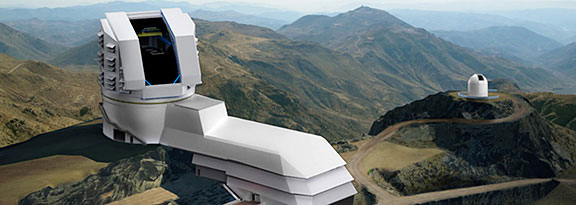
Vera Rubin Observatory atop Cerro Pachon in northern Chile.
Credit: SLAC
The Vera Rubin Observatory is a joint project between the National Science Foundation and the Department of Energy, with significant contributions from Chile, France, and the U.K., and gifts from the Charles Simonyi Fund for Arts and Sciences, Bill Gates, Richard Caris, the W.M. Keck Foundation, Research Corporation for Science Advancement, Wayne Rosing and Dorothy Largay, Eric and Wendy Schmidt, and Edgar Smith. NSF is the lead federal agency, and their responsibilities are managed by the Association of Universities for Research in Astronomy (AURA). DOE responsibilities are managed by the SLAC National Laboratory.
The Vera Rubin Observatory will conduct the Legacy Survey of Space and Time (LSST), a 10-year unprecedented optical survey of the entire visible southern sky using the LSST camera mounted on the 8.4 meter Simonyi Telescope. The camera's 3.2 gigapixels will be the largest digital camera ever built for ground-based optical astronomy, and has so many pixels that displaying one image would required more than 1500 high-definition TV screens. The development of the LSST camera and related instrumentation is funded by DOE HEP, and is one of the flagship projects in the HEP Cosmic Frontier. This work is led by SLAC with significant contributions from over 36 institutions. DOE national labs SLAC, BNL, and LLNL are contributing to the LSST camera construction.
 About the size of a small SUV, the LSST camera is the largest camera ever constructed for astronomy. It is a large-aperture wide field optical camera capable of near UV to near IR wavelengths (320-1050 nm), and weighs 6200 lbs. Credit: SLAC |
 The camera is embedded in a carousel that holds five on-board filters and a 6th filter that can be swapped in ad hoc, each filter having a unique optical band, and can be swapped out in under 2 minutes and up to 4 times per night. Credit: SLAC |
In the 10 year LSST survey, the Vera Rubin Observatory will image the entire visible sky every few nights, recording the greatest timelapse of the Universe ever made. Billions of objects will be seen for the first time and monitored over time, a thousand fold increase over current facilities. The science enabled by the Vera Rubin Observatory includes the nature of Dark Energy and Dark Matter (both are DOE HEP science priorities), as well as cataloging the Solar System, exploring the changing sky, and Milky Way structure and formation. The observatory will operate automatically, capturing an area the size of 40 full moon with each 15-second exposure, returning to the same area of the sky approximately every three nights. Dedicated computer facilities will allow issuing worldwide alerts to interesting phenomena within 60 seconds of detection and allowing other facilities (using optical, radio, gravitational waves, etc) both ground based and in space to correlate observations.
The amount of data coming out of the Vera Rubin Observatory will be unprecedented, and transformational: the 20 TBytes of data collected per night is as much as the entire 10 years of data collected by the Sloan Digital Sky Survey. The ten years of the LSST survey will contribute to building a 500 PByte database of images (1 PByte is roughly equivalent to the digital size of 200,000 full length high definition movies) and a 15 PByte catalog of text data describing properties of nearly 40 billion individual stars and galaxies. Data production work is responsible for the production and support for access to all Vera Rubin Observatory LSST data products. With the Vera Rubin Observatory, the field of astronomy, astrophysics, and cosmology become a significant source of "big data", necessitating new methods of data access, processing, and storage, highly dependent on high performance computing and throughput. SLAC has been selected to manage the US Data Facility, with observatory data to begin flowing sometime around 2022, and with the LSST survey expected to begin in 2024.
Cosmic Microwave Background - Stage 4 (CMB-S4)

The expansion history of the universe showing various phases, especially
the period known as "recombination" at around 370,000
years after the Big Bang
when the universe became transparent to electromagnetic radiation.
Credit: Byran Christie Design
The universe is a closed system (as far as we know), and so all of the mass-energy that exists now has existed since the beginning. We have no idea of the nature of the infinitely dense primordial mass-energy, however we do know that quantum mechanics holds, and so this infinitely dense "stuff" was subject to quantum fluctuations. Those fluctuations seeded perturbations in the primordial mass-energy of the universe at the Big Bang. At around 10-36 seconds after the Big Bang started, the universe entered the Inflationary period, which lasted for perhaps 10-33 – 10-32 seconds, and where the universe expanded in volume by almost 80 orders of magnitude. Such an expansion is equivalent to taking a human blood cell and expanding it to the size of the Milky Way galaxy in a period less than 10-32 seconds. With such an expansion, those primordial perturbations seed the large scale structure that we see today.
As the universe expands and cools, it goes through various phase changes just like any closed system would. In the early times, after the Inflationary era and at around 1 microsecond (10-6 seconds) after the Big Bang, we see the formation of protons and neutrons from quarks, with some relatively small amount of helium. Within minutes after the Big Bang, nuclei can form, but from that time up until around 370,000 years after the Big Bang, this universe was full of charged particles (protons and electrons) with a small amount of ionized helium (deuterons), and of course photons, constituting a giant hot plasma, with a falling thermal temperature as it expanded. In such a universe, neutral hydrogen could form but only for brief periods, since temperature was so large that random collisions with photons and other particles would quickly cause ionization. Such a universe would be opaque to electromagnetic radiation, which means that photons would not be able to travel far before being scattered.
The time period that starts at around 370,000 years after the Big Bang is a special time for the study of cosmology: this is the time when the temperature of the expanding universe fell to a small enough value such that the average kinetic energy of particles started to become significantly lower than the ionization energy of neutral hydrogen. This allowed neutral hydrogen to form for longer periods of time such that after a very short (on cosmological scales) time scale of order 100,000 years, neutral hydrogen dominates the universe. Cosmologists call this the period of "recombination" (a name that is mostly an historical artifact). This universe at recombination was then transparent to electromagnetic radiation, and the photon spectrum decoupled from matter at that time, no longer in thermal equilibrium. This spectrum of cosmic photons then propagates relatively unimpeded through the expanding universe, red shifted from a temperature of around 3000-4000K to the microwave wavelength, or 2.73K, that we measure today. The period of recombination is so special for cosmology because it captures a "snapshot" of the photon spectrum that existed at that time.

Following HEPAP and P5, the community has been gearing up towards such an experiment, now called CMB-S4. The S4 is because this is a "stage-4" measurement, taking the previous stage-3 projects to a new level of sensitivity. As currently envisioned, CMB-S4 would be capable of a sensitivity that would allow measurements that would provide important information that would confirm the theory of Inflation and rule out variations in the different types of Inflation theories, or perhaps rule it out altogether in favor of something new. CMB-S4 would also make a host of other important cosmology measurements, for instance it would be able to construct maps of the history of the expansion of the universe and set limits on whether unknown particles existed in the early universe that we haven't seen at the collider experiments in the Energy Frontier.
 Chile site showing bowl-shaped Atacama Cosmology Telescope (upper right) and the 3 Simons Array telescopes. Credit: University of Pennsylvania |
 South Pole site. Credit: NSF/USAP photo by Robert Schwarz. |
To reach the needed sensitivity, CMB-S4 is envisioned as consisting of large and small aperture telescopes (large apertures are necessary for large multipole moments, and small aperture are optimized for low multipole) at two sites: the high Atacama desert in Chile and the NSF Amundsen-Scott South Pole Research Station. The project passed the DOE CD-0 milestone in July, 2019, and is progressing towards first light in the 2nd half of the current decade.




